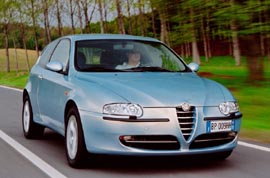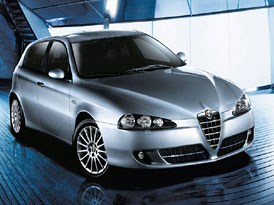
Alfa Romeo 147 Buyers' Guide
Brief History
The Alfa Romeo 147 was released in 2000 at the Turin Motor Show and won the European Car of the Year award with 51 the 56 judges placing it top of their list.

Based on a 156 chassis the 147 replaces both the Alfa 145 and 146. In Singapore the 5-door 147 was introduced in late 2002 and all early versions comes with sunroof as standard feature. The cars come with a choice of 1.6TS 16v (120bhp) and 2.0TS 16v (150bhp) petrol engines, while the 1.6 cars get 5 speed manual transmission and the 2.0 cars got the Selespeed transmission powering the front wheels. In late 2005, the local agent introduced the facelift 147 which only changed the looks but interior remains the same. At the same time, the facelift 1.6 model comes only in the 100bhp version while the 2.0 cars still gets the same 150bhp engine. In 2004 Singapore released the 3.2 litre V6 147GTA.

Suspension is double wishbones at the front with a high upper wishbone, the rear suspension comprises unequal length radius arms and this gives the car a degree of passive rear wheel steering. Styling is by Alfa Romeo’s in house Centro Stile studio.
Body
Check the panel gaps to make sure they are all even as poor fit of panels could mean the car was involved in accident damage. Another tell tale of accident damage is paint chipped off various panel fastenings or nuts and bolts, of course any signs of welding or knocking.
Mechanical
Alfa 147 are very reliable cars if serviced well, however as with all vehicles there are a number of things to look out for when purchasing. The TS engines ‘drinks’ oil and if when you check the oil there is little or none in the sump this is an indication that the car has been neglected it is probably best to walk away at this point. The timing belts should have been replaced at the 60,000km service.
On cold start, if there is rattling from the 4 cylinder engines that sound like a diesel, this is caused by worn cam variator and need to be replaced. This sound goes away once the car is warmed up so we suggest to view the car early in the morning be the first one to do a cold start.
The V6 engines should also have had their timing belt changed at 60,000km and it is advisable to replace the water pump while doing this as the impellers are made of plastic and have a tendency to crack. The original spark plugs last 100,000km but we recommend changing them at 80,000km interval for best performance. We only recommend original spark plugs as no other plugs works better.
If you find there is lack of power during test driving, it usually means the airflow meter is faulty, which could lead to lost of 10-20bhp and erratic idling.
Clutches and gear boxes are very generally reliable. Clutch pedal action is fairly light and smooth on the 1.6 cars, a worn clutch will tend to bite at the top of its travel and as they are self adjusting a high biting point signifies that a new clutch will be needed soon. In the 1.6 cars, the clutch master pump is also known to fail and cause sticky clutch problem. Gear boxes are generally trouble free but do check that all gears engage smoothly without crunching, On selespeed cars make sure that you check that all of the different ways of changing gear are used i.e. the paddles, the gear knob and city mode.
Suspension has a number of areas to check these are the upper wishbone which can have play at either end and may manifest itself as a creak coming from behind the dash. If you hear knocking sound from front when going through uneven roads, it usually means that the front lower arm or front antiroll bar needs to be replaced. The rear suspension rear arm bushes wear as do the bushes in the rear hub, you will know this if you see uneven rear tyre wear and this is usually on the inner edge of the tyre.
Electronics
The interior electrics are generally very reliable but just give it a quick check that everything works well. Check fan, electric mirrors, electric windows, lighter, radio, climate control, windscreen wipers, windscreen washers, lights, sun roof, boot release, petrol flap release and rear window wiper.
When you start the car 3 important systems (air bag, ABS, engine management) are checked by the car, so do not crank the engine straight away! These 3 systems have a warning light that illuminates on start up and will go out after a few seconds. So if the lights does NOT come on or stays on then there is a fault with that system and needs to be fixed. The air bag light is a little man with a large balloon in front of him that is situated on the bottom left between the rev counter and speedo. The ABS light is a circle with ABS written in the centre which is again between the two instruments and the fuel injection light is in the top right of the rev counter and looks like a yellow engine. The display in the centre of the dash should also display warnings of any faults.
The 147 also has a CAN line that connects the various computers round the car any faults on any of the monitored systems are indicated by a flashing odometer, so if the mileage is flashing there could be a fault with anything from the driver door to the fuel tank sender!
This is a basic guide to buying an Alfa 147. It is also advisable for you to bring your car to an Alfa specialist to check the car one last time before buying the car.